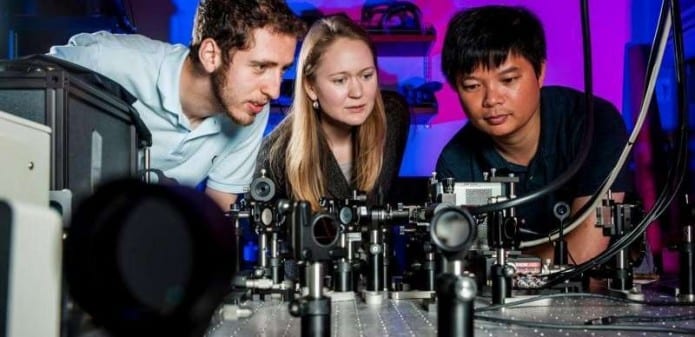Researchers use Plasmonics to develop super-fast light device that can be used in optical computing
The microscopic ultra-fast light emitting device can flash 90 billion times per second and could form the basis of optical computing.
Researchers have now used Plasmonics, a branch of Physics, to develop a microscopic device which can flip light on and off at an amazing rate of 90 billion times per second.
Basically, if we consider the case of our smartphone’s battery, it can power billions of transistors just by using electrons to flip on and off billions of times per second. Suppose, instead of photons microchips started using electrons for processing and transmit the data then computers would be able to operate much faster.
To build such a super fast computer, it is essential to build an ultra-fast light source which can turn on and off rapidly. One can think lasers would be the most apt answer to match this requirement; however lasers consume too much energy and at the same time are too hefty to integrate into the computer chips.
Researchers from the Pratt School of Engineering at Duke University have now found an answer to such a light source which can form the basis of optical computing.
The study revealed that when laser light pulses onto the cubes it causes a series of excitation which leads to creation of plasmon which is nothing but combination of light and free electrons.
Theoretically, the system comprises of a square lump which is the size of 75 nanometers. The microscopic device consists of a thin sheet gold which is placed mere 20 atoms beneath and the area in between is scattered with a series of spheres that are made up of semi conducting material each of which is almost six nanometers in width and known as quantum dots (the pink things seen in the square).
It is this accurate spacing between the gold sheet and the cube which creates a field between the two which triggers the excitation of the quantum dots at an incredibly high frequency, around 90 gigahertz in this case. It is this excitation which results in the emission of light from the quantum dots that pulses on and off at the rate of 90 billions per second.
The findings and results of this study has been published in the July 27 edition of the journal Nature Communications.
Maiken Mikkelsen, an assistant professor of electrical and computer engineering and physics at Duke said: “This is something that the scientific community has wanted to do for a long time. We can now start to think about making fast-switching devices based on this research, so there’s a lot of excitement about this demonstration.”
Let us try to understand how researchers used the Plasmonics in their study:
Researchers used the branch of physics, Plasmonics, to achieve this new speed record. During the study laser was made to shine on the surface of the silver cube which was only 75 nanometers in width, now the free electrons from the surface began oscillating together in the form of a wave. The oscillations resulted in formation of some sort of light which reacted again with the free electrons. As an outcome of the entire process energy got trapped on the surface of the nanocube which is known as plasmon.
Due to the plasmon, an intense electromagnetic field gets generated between the silver nanocube and the thin sheet of gold which is placed at a microscopic distance of 20 atoms. It is this electromagnetic field which interacts with the quantum dots or the spheres of semiconducting materials which have been placed at a distance of six nanometers from each other and are in fact sandwiched in between the nanocube and the gold sheet.
These quantum dots are the ones which actually produce a directional efficient emission of photons which can be turned on and off at a speed of more than 90 gigahertz.
Gleb Akselrod, a postdoctoral research in Mikkelsen’s laboratory said: “There is great interest in replacing lasers with LEDs for short-distance optical communication, but these ideas have always been limited by the slow emission rate of fluorescent materials, lack of efficiency and inability to direct the photons. Now we have made an important step towards solving these problems.”
“The eventual goal is to integrate our technology into a device that can be excited either optically or electrically,” said Thang Hoang, also a postdoctoral researcher in Mikkelsen’s laboratory. “That’s something that I think everyone, including funding agencies, is pushing pretty hard for.”
The research team reckons that by using the ultra-high frequency of light emission one can create newer kinds of ultra-fast light circuitry which can be used to transmit data. However, to achieve this in reality the researchers would require a place a single quantum dot in between the nanocube and gold sheet to create the single photon source, which is definitely not an easy task!
“By tailoring the environment around a material, like we’ve done here with semiconductors, we can create new designer materials with almost any optical properties we desire,” said Mikkelsen. “And that’s an emerging area that’s fascinating to think about.”
